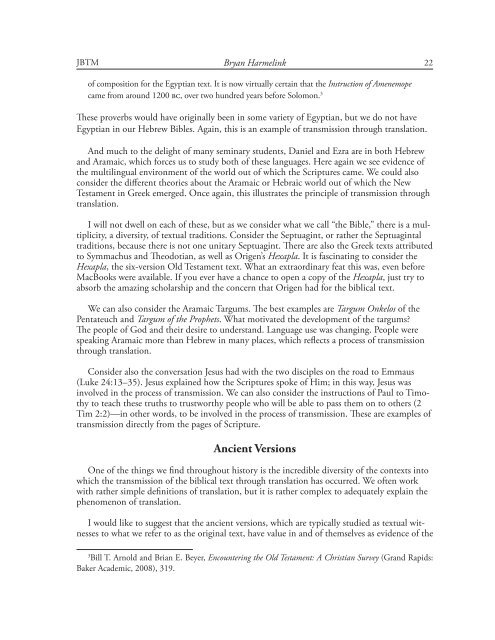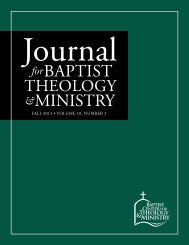Bible Translation as Missions
pTf2MG
pTf2MG
You also want an ePaper? Increase the reach of your titles
YUMPU automatically turns print PDFs into web optimized ePapers that Google loves.
JBTM Bryan Harmelink22of composition for the Egyptian text. It is now virtually certain that the Instruction of Amenemopecame from around 1200 bc, over two hundred years before Solomon. 3These proverbs would have originally been in some variety of Egyptian, but we do not haveEgyptian in our Hebrew <strong>Bible</strong>s. Again, this is an example of transmission through translation.And much to the delight of many seminary students, Daniel and Ezra are in both Hebrewand Aramaic, which forces us to study both of these languages. Here again we see evidence ofthe multilingual environment of the world out of which the Scriptures came. We could alsoconsider the different theories about the Aramaic or Hebraic world out of which the NewTestament in Greek emerged. Once again, this illustrates the principle of transmission throughtranslation.I will not dwell on each of these, but <strong>as</strong> we consider what we call “the <strong>Bible</strong>,” there is a multiplicity,a diversity, of textual traditions. Consider the Septuagint, or rather the Septuagintaltraditions, because there is not one unitary Septuagint. There are also the Greek texts attributedto Symmachus and Theodotian, <strong>as</strong> well <strong>as</strong> Origen’s Hexapla. It is f<strong>as</strong>cinating to consider theHexapla, the six-version Old Testament text. What an extraordinary feat this w<strong>as</strong>, even beforeMacBooks were available. If you ever have a chance to open a copy of the Hexapla, just try toabsorb the amazing scholarship and the concern that Origen had for the biblical text.We can also consider the Aramaic Targums. The best examples are Targum Onkelos of thePentateuch and Targum of the Prophets. What motivated the development of the targums?The people of God and their desire to understand. Language use w<strong>as</strong> changing. People werespeaking Aramaic more than Hebrew in many places, which reflects a process of transmissionthrough translation.Consider also the conversation Jesus had with the two disciples on the road to Emmaus(Luke 24:13–35). Jesus explained how the Scriptures spoke of Him; in this way, Jesus w<strong>as</strong>involved in the process of transmission. We can also consider the instructions of Paul to Timothyto teach these truths to trustworthy people who will be able to p<strong>as</strong>s them on to others (2Tim 2:2)—in other words, to be involved in the process of transmission. These are examples oftransmission directly from the pages of Scripture.Ancient VersionsOne of the things we find throughout history is the incredible diversity of the contexts intowhich the transmission of the biblical text through translation h<strong>as</strong> occurred. We often workwith rather simple definitions of translation, but it is rather complex to adequately explain thephenomenon of translation.I would like to suggest that the ancient versions, which are typically studied <strong>as</strong> textual witnessesto what we refer to <strong>as</strong> the original text, have value in and of themselves <strong>as</strong> evidence of the3Bill T. Arnold and Brian E. Beyer, Encountering the Old Testament: A Christian Survey (Grand Rapids:Baker Academic, 2008), 319.



